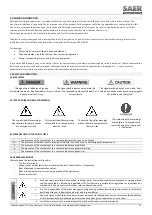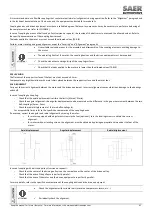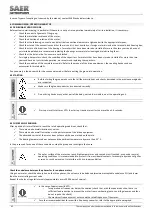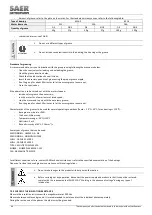
Keep the manual for future reference – For more informations visit www.saerelettropompe.com
45
Measurement of the insulation resistance must be carried out with the motor off and cold. Higher motor temperature values considerably
lower the insulation resistance values.
·
The motor must be disconnected from the electrical power s
upply
.
·
In the case of single-phase motors, discharge the capacitor completely before the test.
The measurement must last for one minute.
The resistance of a new winding must be greater than 20M
W
at an ambient temperature of 20°C with a test voltage of 500Vdc.
In case of different ambient temperature values, refer to TAB.XI for the correction values. The measured value must be multiplied by the
correction factor corresponding to the ambient temperature at which the measurement was made according to the following formula:
R
20°C
=R
ta
*Fc
R
20°C
>20M
R
ta
*Fc>20M
R
20°C
: Insulation resistance measured at 20°C
R
ta
: Insulation resistance measured at ambient temperature
Fc
: Correction factor
û
Do not touch the motor during and after measuring the insulation resistance. After the measurement,
discharge the windings before carrying out any other operation.
8. DECOMMISSIONING AND DISPOSAL
At the end of operating life of the motor or any of its parts, the disposal must be carried out according to local regulations in force. This also
applies to the lubricants, with particular regard if classified toxic or harmful, and for the packaging.
Refer to the information on disposal in accordance with the WEEE Directive 2012/19/EU given in this manual.
In case it is necessary to return the motor to the supplier:
®
clean the motor thoroughly;
®
if necessary, provide for a complete decontamination of the product;
®
remove any residual liquids or greases (lubricants etc ...);
®
do not return the motor open;
®
protect the motor from the risk of corrosion and pack it carefully;
®
indicate to the supplier any safety measures applied.
·
It is the responsibility of the person returning the material to ensure that all necessary measures have been
taken to guarantee the safety of the product and that the return is in accordance with the provisions of the
law in force.
9. TROUBLESHOOTING
FAILURE OR MALFUNCTION
ID
PROBABLE CAUSE
SOLUTION
!
The motor does not
start (coupled or not
coupled to the driven
equipment)
A.1
→
There is no voltage coming to the motor
cable
Check the power supply and related control and protection
equipment
A.2
→
The fuses are blown
Replace the fuses
A.3
→
Connection error
Correct the connection according to the connection
diagrams
A.4
→
The power cable is interrupted
Repair or replace the cable
A.5
→
Rotor shaft blocked
Check the free rotation of the shaft. Replace any damaged
components (bearings, etc ...)
A.6
→
The capacitor is faulty (only for single-phase
motors)
Replace the capacitor
!
The motor does not
start (only if not
coupled to the driven
equipment)
B.1
→
Torque required by the driven equipment
too high
Check the correct conditions of use of the driven
equipment. If possible, reduce the load applied during
start-up. Check that the motor is suitable for driving the
equipment.
B.2
→
Too high voltage drop
Check the sizing of the power supply (cable section,
transformer, switches etc ...)




































